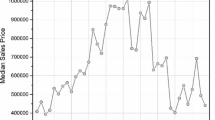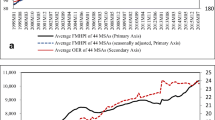Abstract
Global sea level rise is a known consequence of climate change. As predictions of sea level rise have grown in magnitude and certainty, coastal real estate assets face an increasing climate risk. I use a complete data set of repeated home sales from Long Island in New York State to estimate the appreciation discount caused by the threat of sea level rise. The repeat sale methodology allows for time-invariant, unobserved property characteristics to be controlled for. Between 2000 and 2017, I find that residential properties that were exposed to future sea level rise experienced an annual price appreciation rate of roughly 1% point below unexposed properties. I provide numerous robustness checks to confirm this result. I also find evidence of demand spillovers by estimating an appreciation premium for properties that are near the coast but are relatively safe from sea level rise.








Similar content being viewed by others
Data Availability
Upon request.
Code Availability
Upon request.
References
Atreya, A., & Czajkowski, J. (2019). Graduated flood risks and property prices in Galveston county. Real Estate Economics, 47(3), 807–844.
Atreya, A., & Ferreira, S. (2015). Seeing is believing? Evidence from property prices in inundated areas. Risk Analysis, 35(5), 828–848.
Bakkensen, L. A., & Barrage, L. (2018). Flood risk belief heterogeneity and coastal home price dynamics: Going under water? Technical report. National Bureau of Economic Research.
Baldauf, M., Garlappi, L., & Yannelis, C. (2020). Does climate change affect real estate prices? Only if you believe in it. The Review of Financial Studies, 33(3), 1256–1295.
Bernstein, A., Gustafson, M. T., & Lewis, R. (2019). Disaster on the horizon: The price effect of sea level rise. Journal of Financial Economics, 134(2), 253–272.
Billings, S. B. (2015). Hedonic amenity valuation and housing renovations. Real Estate Economics, 43(3), 652–682.
Bin, O., & Landry, C. E. (2013). Changes in implicit flood risk premiums: Empirical evidence from the housing market. Journal of Environmental Economics and Management, 65(3), 361–376.
Bunten, D., & Kahn, M. E. (2017). Optimal real estate capital durability and localized climate change disaster risk. Journal of Housing Economics, 36, 1–7.
Chen, X., Zhang, X., Church, J. A., Watson, C. S., King, M. A., Monselesan, D., Legresy, B., & Harig, C. (2017). The increasing rate of global mean sea-level rise during 1993–2014. Nature Climate Change, 7(7), 492–495.
Chivers, J., & Flores, N. E. (2002). Market failure in information: The national flood insurance program. Land Economics, 78(4), 515–521.
Church, J. A., Clark, P. U., Cazenave, A., Gregory, J. M., Jevrejeva, S., Levermann, A., Merrifield, M. A., Milne, G. A., Nerem, R. S., Nunn, P. D., et al. (2013). Sea level change. Technical report. Cambridge University Press.
Conroy, S. J., & Milosch, J. L. (2011). An estimation of the coastal premium for residential housing prices in San Diego County. The Journal of Real Estate Finance and Economics, 42(2), 211–228.
Desmet, K., & Rossi-Hansberg, E. (2015). On the spatial economic impact of global warming. Journal of Urban Economics, 88, 16–37.
Eichholtz, P., Steiner, E., & Y¨onder, E. (2019). Where, when, and how do sophisticated investors respond to flood risk? Available at SSRN 3206257.
Gibson, M., & Mullins, J. (2020). Climate risk and beliefs in New York City floodplains. Journal of the Association of Environmental and Resource Economists, 7, 1069.
Hino, M., & Burke, M. (2020). Does information about climate risk affect property values? Technical report. National Bureau of Economic Research.
Kahn, M. E. (2014). Climate change adaptation: Lessons from urban economics. Technical report. National Bureau of Economic Research.
Kahn, M. E. (2016). The climate change adaptation literature. Review of Environmental Economics and Policy, 10(1), 166–178.
Kousky, C., Kunreuther, H., LaCour-Little, M., & Wachter, S. (2020). Flood risk and the US housing market. Journal of Housing Research, 29(sup1), S3–S24.
Kousky, C., & Shabman, L. (2014). Pricing flood insurance: How and why the nfip differs from a private insurance company. Resources for the Future Discussion Paper. https://doi.org/10.2139/ssrn.2537915
Kriesel, W., & Landry, C. (2004). Participation in the national flood insurance program: An empirical analysis for coastal properties. Journal of Risk and Insurance, 71(3), 405–420.
McCoy, S. J., & Zhao, X. (2018). A city under water: A geospatial analysis of storm damage, changing risk perceptions, and investment in residential housing. Journal of the Association of Environmental and Resource Economists, 5(2), 301–330.
McKenzie, R., & Levendis, J. (2010). Flood hazards and urban housing markets: The effects of Katrina on New Orleans. The Journal of Real Estate Finance and Economics, 40(1), 62–76.
McNamara, D. E., & Keeler, A. (2013). A coupled physical and economic model of the response of coastal real estate to climate risk. Nature Climate Change, 3(6), 559–562.
Murfin, J., & Spiegel, M. (2020). Is the risk of sea level rise capitalized in residential real estate? The Review of Financial Studies, 33(3), 1217–1255.
Nicholls, R. J., & Cazenave, A. (2010). Sea-level rise and its impact on coastal zones. Science, 328(5985), 1517–1520.
Ortega, F., & Taspinar, S. (2018). Rising sea levels and sinking property values: Hurricane Sandy and New York’s housing market. Journal of Urban Economics, 106, 81–100.
Seneviratne, S., Nicholls, N., Easterling, D., Goodess, C., Kanae, S., Kossin, J., Luo, Y., Marengo, J., McInnes, K., Rahimi, M., et al. (2012). Changes in climate extremes and their impacts on the natural physical environment.
Severen, C., Costello, C., & Deschenes, O. (2018). A forward-looking ricardian approach: Do land markets capitalize climate change forecasts? Journal of Environmental Economics and Management, 89, 235–254.
Sklarz, M., & Miller, N. (2018). The impact of waterfronts on residential home values, part 2: Considering climate change and flood risks.
Votsis, A., & Perrels, A. (2016). Housing prices and the public disclosure of flood risk: A difference-in-differences analysis in finland. The Journal of Real Estate Finance and Economics, 53(4), 450–471.
Yi, D., & Choi, H. (2019). Housing market response to new flood risk information and the impact on poor tenant. The Journal of Real Estate Finance and Economics, 61, 55–79.
Zhang, L., & Leonard, T. (2019). Flood hazards impact on neighborhood house prices. The Journal of Real Estate Finance and Economics, 58(4), 656–674.
Funding
None.
Author information
Authors and Affiliations
Corresponding author
Ethics declarations
Conflict of interest
The authors declare that they have no conflict of interest to disclose.
Additional information
Publisher's Note
Springer Nature remains neutral with regard to jurisdictional claims in published maps and institutional affiliations.
Appendices
Appendix A
In Table 5, I provide results where I limit the sample to properties within 2 km of the coast. In Fig. 9, I provide an elevation map where I indicate which areas of Long Island are within 2 km of the coast. On the south coast, much of this area is at very low elevations, whereas the north coast contains steeper terrain that extends to higher elevations
Appendix B
To generate the sample of properties used in analysis, I drop a number of observations to focus the sample on observations that are most relevant to the research question and fit with the repeat sales methodology. In this Appendix, I provide results using alternative samples to test the robustness of results. Overall, I find results are not generally sensitive to the specific decisions made regarding which observations are dropped.
I limit the sample to only properties that sold multiple times in order to include fixed effects at the property level. If properties that sell frequently are not representative of overall trends in the market the regression results will also not be representative of the overall market. In Table 8, I show results among properties that sold exactly twice, rather than at least two times. If the bias in the repeat sale sample is correlated with sale frequency, this subsample should be more representative of the overall market. I find results on the limited sample are robust and estimates are very close to the full repeat sale sample analysis (Table 2).
The analysis of this paper is focused on the housing market. I exclude other property types, particularly commercial and agriculturally zoned land. These non-housing property types make up 4.4% of transactions. In Table 9, I repeat the main analysis but include these other property types. I find results are very similar to the main estimates of the paper.
Appendix C
Table 10 provides split sample results where the effect of exposure is estimated separately for properties on the North and South sides of the study area. I split the sample area with a line that runs equidistant from the north and south coasts.
I find that the significant negative price effect of exposure is driven by properties on the south coast. In fact, I find a marginally significant positive price effect for exposure on the north coast (column 1). Because hurricane activity approaches from the south, the north coast is largely protected from storm surge events. The marginally positive price effect could be evidence of demand substitution towards coastal properties that are considered to be relatively low risk
Appendix D
In Table 11, I provide a horse-race regression where I include the elevation based at risk definition simultaneously with the FEMA flood zone definition. Across the three regressions, I find that all six coefficients are negative, though not all are statistically significant. The result suggests that conditional on elevation, homes within FEMA defined flood zones appreciated less quickly. Also, the result suggests that conditional on being in a flood zone, lower elevation properties suffered a greater price penalty. The two risk indicators are highly correlated, potentially leading to multicollinearity issues. Therefore, the results should be interpreted with caution
Rights and permissions
About this article
Cite this article
Tyndall, J. Sea Level Rise and Home Prices: Evidence from Long Island. J Real Estate Finan Econ 67, 579–605 (2023). https://doi.org/10.1007/s11146-021-09868-8
Accepted:
Published:
Issue Date:
DOI: https://doi.org/10.1007/s11146-021-09868-8





